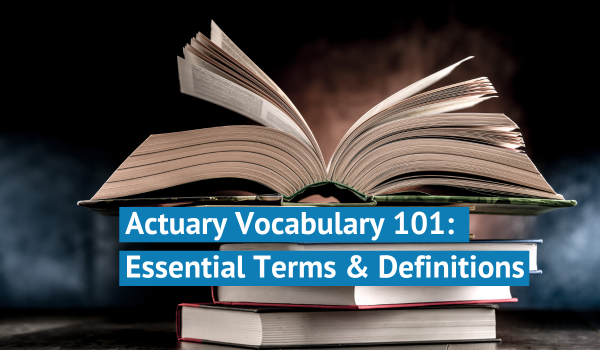Actuary Vocabulary 101: Essential Terms and Definitions
July 1, 2024|Stephanie Irvin

Although we’re not in the medical or military field with their myriad of acronyms and seemingly invented words, our professional realm isn’t exactly lacking in its own perplexing terminology either. That’s why we crafted this guide – to make things a bit easier. If it helps, great! If not, feel free to close this tab; no hard feelings. But if you ever need it, it’ll be here.
I’ve been in your shoes. When I first joined Odyssey, I felt like a fish out of water and Google was my constant friend. If you had peeked at my search history four years ago, it would’ve looked something like this:
“What is OPEB?”
“Is it Other Postemployment Benefits or Other Post-Employment Benefits?”
“What’s the difference between TOL and NOL?“
Without an actuarial background, I needed time to catch up. But with the invaluable support from our amazing team, I soon found my footing. This guide is designed to help you find yours. I hope it helps!
Top Actuarial Terms & Definitions:
- Actuarial Accrued Liability (“AAL”): AAL is the present value of benefits earned by employees to date, calculated based on actuarial assumptions.
- Actuarial Assumptions: Actuarial Assumptions are estimates used by actuaries to calculate future benefit obligations, including rates of retirement, turnover, and salary growth.
- Amortization: The process of spreading out payments or expenses over time. In the context of OPEB (our area of expertise), it often refers to the period over which changes in unfunded liabilities are recognized through the expense.
- Actuarially Determined Contribution (“ADC”): “ADC”, not to be confused with “ACDC” is the contribution amount determined or calculated by an actuary for a pension or OPEB plan for a year which includes the normal cost and an amortization payment for any unfunded liability. This figure is designed to help a plan reach “full” funding over some time.
- Assumption Testing: This is the process by which both actuaries and auditors evaluate the reasonableness and appropriateness of actuarial assumptions used in valuations. For our auditor friends, we recently published this article: Auditing the Actuary: Assumption Testing
- Cash Balance Plan (“CB Plan”): CB Plans are a type of defined benefit retirement plan (“DB plan”) that combines features of both traditional DB plans and defined contribution plans (“DC plans”) and is often used by small business owners with high, predictable income. It allows for significant tax-deductible contributions each year and the accumulation of retirement assets which are both tax-deferred and protected from creditors. To learn more about CB plans and their benefits, check out this article: What is a Cash Balance Plan?
- Census Testing: Census Testing is the process used by auditors to verify the accuracy and completeness of the participant data used in an actuarial valuation by checking the demographic and employment information, such as age, service duration, and benefit data to ensure that it is correct and corresponds to the actual records of the participants.
- Defined Benefit Plan (“DB Plan”): A Defined Benefit Plan is a retirement plan that promises a specified monthly benefit at retirement, which is typically based on salary and years of service (collectively bargained or union plans often will use a fixed dollar amount multiplied by years of service). The key thing to remember is that the plan sponsor or the employer bears any investment or mortality risk. These plans are also known as a pension plan.
- Defined Contribution Plan (“DC Plan”): A DC plan is a retirement plan where the employer, employee, or both, contribute to an individual account for the employee, with benefits based on the account balance at retirement. Unlike a DB plan, with a Defined Contribution Plan, the employee or participant is normally responsible for some or all investment decisions.
- Discount Rate: The discount rate is the interest rate used to determine the present value of future benefit obligations. Essentially, the discount rate is a tool that helps our actuaries determine how much money needs to be set aside today to cover the future pension or OPEB benefit payments owed to employees. To learn more, check out this article: Top 5 Factors That Determine Your OPEB Discount Rate
- Funding Ratio: The ratio of a plan’s assets to its liabilities, indicating the financial health of the plan.
- Governmental Accounting Standards Board (“GASB”): GASB is the organization that sets accounting and financial reporting standards for U.S. state and local governments, including standards for pension and OPEB plans.
- GASB 67: GASB 67 is a specific set of rules created by GASB that focuses on how state and local government pension plans should report their financial information to ensure they are accurate, consistent, and provide a true reflection of their financial position.
- GASB 68: GASB 68 is a similar set of rules issued by GASB that focuses on how government employers should report their pension obligations in their financial statements.
Still curious about the GASB 67 & 68? Check out this article: GASB 67 & GASB 68: What’s the Difference?
- GASB 74: GASB 74 is a standard set by GASB that focuses on the financial reporting of Other Post-Employment Benefits (OPEB). The focus of GASB 74 is on the OPEB plans’ financial reporting.
- GASB 75: GASB 75 is a standard set by GASB that focuses on the financial reporting by the government employers who sponsor OPEB plans related to their participation in those plans.
Want to learn more? Read this article: What is the Difference Between GASB 74 and GASB 75?
- Healthcare Cost Trend Rate: The rate at which healthcare costs are expected to increase over time. This is an important assumption in OPEB valuations.
- Income-Related Monthly Adjustment Amount (“IRMAA”): IRMAA is an additional charge that some higher-income Medicare beneficiaries must pay for their Medicare Part B (medical insurance) and Medicare Part D (prescription drug coverage) premiums.
- Net OPEB Expense: This is the expense (on an accrual basis) that is recognized annually on the financial statement.
- Net OPEB Liability (“NOL”): NOL is the difference between the total OPEB liability (TOL) and the plan’s fiduciary net position (assets), representing the unfunded portion of OPEB obligations.
- Calculation: NOL = TOL – FNP
- Net Pension Liability (“NPL”): This is the difference between Total Pension Liability (TPL) and the plan’s fiduciary net position (assets). In simpler terms, it’s the amount by which the pension plan’s obligations for both current and future retirees exceed the current assets available.
- Calculation: NPL = TPL – FNP
- Normal Cost: The portion of the present value of projected benefits allocated to the current year, reflecting the cost of benefits earned by employees in the current year.
- OPEB (“Other Post-Employment Benefits”): Refers to the benefits, other than Pensions, that employees receive after they retire from service. These benefits typically include health insurance, dental, vision, prescription, life insurance, long-term care, and other similar benefits.
- OPEB Trust: An OPEB Trust is a financial arrangement established by a government or public sector employer to pre-fund Other Post-Employment Benefits for their employees. Essentially it’s an account to set aside funds today to meet the future OPEB obligations of retired employees to ensure that these benefits can be paid when due. The funds can be invested, potentially earning returns that help reduce the total cost of providing OPEB over time.
- Pay-as-You-Go (“Pay-Go”) Funding: A method of funding OPEB benefits where benefits are paid from current revenues rather than pre-funding through a trust.
- Plan Fiduciary Net Position: The market value of assets held in trust to pay OPEB or pension benefits.
- Present Value: When we talk about determining the present value of future benefit obligations, we’re talking about figuring out how much those future payments are worth in today’s terms.
- Safe Harbor 401(k) Plan: A type of 401(k) plan designed to automatically pass the IRS nondiscrimination tests, which ensure that the plan benefits both rank-and-file employees and highly compensated employees. To qualify, employers must make mandatory contributions that are fully vested immediately. This plan simplifies administration and ensures that all employees benefit fairly from the plan.
- Service Cost: Another term for normal cost, which is the value of the benefits that eligible employees accrue each year.
- SIMPLE 401(k) Plan: A SIMPLE (“Savings Incentive Match Plan for Employees”) 401(k) plan is a retirement plan designed for businesses with 100 or fewer employees. It combines the features of a traditional 401(k) with those of a SIMPLE IRA. Employers are required to make either matching contributions or non-elective contributions to employee accounts. Contributions are tax-deferred, and the plan is subject to simpler and less costly administration than traditional 401(k) plans.
- Third-Part Administrator (“TPA”): A TPA for retirement plans is an independent entity that provides administrative services to employers sponsoring retirement plans, such as 401(k)s and pension plans. TPAs handle various tasks such as plan design, recordkeeping, compliance testing, reporting and filings, regulatory updates, and more to ensure the plan operates smoothly and remains compliant with requirements.
Want to learn more? Read this article: Here’s Why You Need a Third Party Administrator (and How to Hire the Right One)
- Total OPEB Liability (“TOL”): TOL is the value of OPEB benefits that have been earned by active and retired employees.
- Total Pension Liability (“TPL”): Similar to TOL, TPL is the present value of all future pension payments owed to employees based on their service to date.
- Traditional 401(k) Plan: An employer-sponsored retirement savings plan that allows employees to contribute a portion of their salary on a pre-tax basis. Contributions are invested in various investment options chosen by the employee, and the funds grow tax-deferred until they are withdrawn in retirement.
- Unfunded Actuarial Accrued Liability (“UAAL”): The portion of the actuarial accrued liabilities not covered by plan assets, indicating the amount by which the plan is underfunded.
- Vesing: The process by which employees earn the right to receive benefits from a pension, OPEB, or retirement plan, usually after the completion of required years of service.
So, the next time someone calls you to ask about TOL or how NOL is calculated on your next OPEB valuation report, you’ll be able to answer with confidence!
Want to learn more? Visit our insights page and check out our new video series, “Ask an Actuary,” for in-depth articles and videos covering these topics and much more.
If you still have questions, feel free to reach out to us here. Whether your question is simple or complex, we’re here to help!

About The Author Stephanie joined the Odyssey Advisor’s team all the way from the Lonestar state in November of 2020. She is versatile in her abilities and has experience in copywriting, photography, and analytics. She helps tell our brand story and convey...
More Insights From This author

September 2, 2025
Stephanie Irvin

October 15, 2024
Stephanie Irvin

November 29, 2023
Stephanie Irvin

November 15, 2023
Stephanie Irvin




